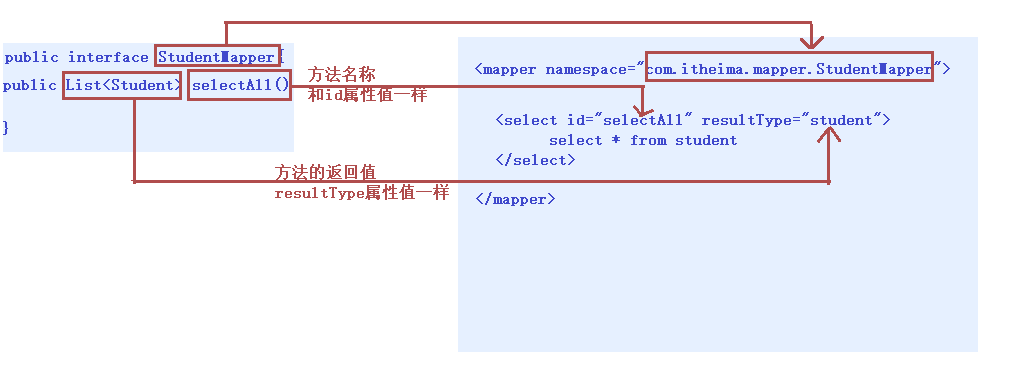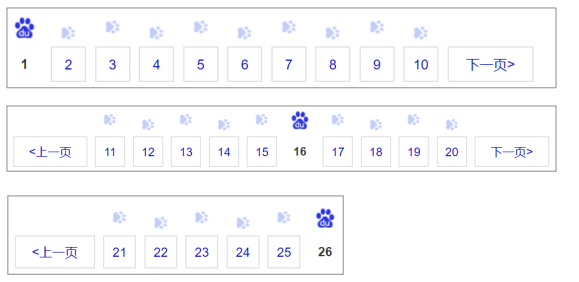一.接口代理方式实现Dao
1.1 代理开发方式介绍
? 采用 Mybatis 的代理开发方式实现 DAO 层的开发,这种方式是我们后面进入企业的主流。
Mapper 接口开发方法只需要程序员编写Mapper 接口(相当于Dao 接口),由Mybatis 框架根据接口定义创建接口的动态代理对象,代理对象的方法体同上边Dao接口实现类方法。
Mapper 接口开发需要遵循以下规范:
1) Mapper.xml文件中的namespace与mapper接口的全限定名相同
2) Mapper接口方法名和Mapper.xml中定义的每个statement的id相同
3) Mapper接口方法的输入参数类型和mapper.xml中定义的每个sql的parameterType的类型相同
4) Mapper接口方法的输出参数类型和mapper.xml中定义的每个sql的resultType的类型相同
总结:
接口开发的方式: 程序员只需定义接口,就可以对数据库进行操作,那么具体的对象怎么创建?
1.程序员负责定义接口
2.在操作数据库,mybatis框架根据接口,通过动态代理的方式生成代理对象,负责数据库的crud操作
1.2.编写StudentMapper接口

1.3 测试代理方式
public Student selectById(Integer id) {
Student stu = null;
SqlSession sqlSession = null;
InputStream is = null;
try{
//1.加载核心配置文件
is = Resources.getResourceAsStream("MyBatisConfig.xml");
//2.获取SqlSession工厂对象
SqlSessionFactory sqlSessionFactory = new SqlSessionFactoryBuilder().build(is);
//3.通过工厂对象获取SqlSession对象
sqlSession = sqlSessionFactory.openSession(true);
//4.获取StudentMapper接口的实现类对象
StudentMapper mapper = sqlSession.getMapper(StudentMapper.class); // StudentMapper mapper = new StudentMapperImpl();
//5.通过实现类对象调用方法,接收结果
stu = mapper.selectById(id);
} catch (Exception e) {
} finally {
//6.释放资源
if(sqlSession != null) {
sqlSession.close();
}
if(is != null) {
try {
is.close();
} catch (IOException e) {
e.printStackTrace();
}
}
}
//7.返回结果
return stu;
}1.4 源码分析
分析动态代理对象如何生成的?
通过动态代理开发模式,我们只编写一个接口,不写实现类,我们通过 getMapper() 方法最终获取到 org.apache.ibatis.binding.MapperProxy 代理对象,然后执行功能,而这个代理对象正是 MyBatis 使用了 JDK 的动态代理技术,帮助我们生成了代理实现类对象。从而可以进行相关持久化操作。
分析方法是如何执行的?
动态代理实现类对象在执行方法的时候最终调用了 mapperMethod.execute() 方法,这个方法中通过 switch 语句根据操作类型来判断是新增、修改、删除、查询操作,最后一步回到了 MyBatis 最原生的 SqlSession 方式来执行增删改查。
1.5 知识小结
接口代理方式可以让我们只编写接口即可,而实现类对象由 MyBatis 生成。
实现规则 :
- 1.映射配置文件中的名称空间必须和 Dao 层接口的全类名相同。
- 2.映射配置文件中的增删改查标签的 id 属性必须和 Dao 层接口的方法名相同。
- 3.映射配置文件中的增删改查标签的 parameterType 属性必须和 Dao 层接口方法的参数相同。
- 4.映射配置文件中的增删改查标签的 resultType 属性必须和 Dao 层接口方法的返回值相同。 ?
- 5.获取动态代理对象 SqlSession 功能类中的 getMapper() 方法。
二. 动态sql语句
2.1 动态sql语句概述
Mybatis 的映射文件中,前面我们的 SQL 都是比较简单的,有些时候业务逻辑复杂时,我们的 SQL是动态变化的,此时在前面的学习中我们的 SQL 就不能满足要求了。
参考的官方文档,描述如下:

2.2 动态 SQL 之<if>
我们根据实体类的不同取值,使用不同的 SQL语句来进行查询。比如在 id如果不为空时可以根据id查询,如果username 不同空时还要加入用户名作为条件。这种情况在我们的多条件组合查询中经常会碰到。
如下图:
<select id="findByCondition" parameterType="student" resultType="student">
select * from student
<where>
<if test="id!=0">
and id=#{id}
</if>
<if test="username!=null">
and username=#{username}
</if>
</where>
</select>当查询条件id和username都存在时,控制台打印的sql语句如下:
… … …
//获得MyBatis框架生成的StudentMapper接口的实现类
StudentMapper mapper = sqlSession.getMapper( StudentMapper.class);
Student condition = new Student();
condition.setId(1);
condition.setUsername("lucy");
Student student = mapper.findByCondition(condition);
… … …
当查询条件只有id存在时,控制台打印的sql语句如下:
… … … //获得MyBatis框架生成的UserMapper接口的实现类 StudentMapper mapper = sqlSession.getMapper( StudentMapper.class); Student condition = new Student(); condition.setId(1); Student student = mapper.findByCondition(condition); … … …

总结语法:
<where>:条件标签。如果有动态条件,则使用该标签代替 where 关键字。 <if>:条件判断标签。 <if test=“条件判断”> 查询条件拼接 </if>
2.3 动态 SQL 之<foreach>
循环执行sql的拼接操作,例如:SELECT * FROM student WHERE id IN (1,2,5)。
<select id="findByIds" parameterType="list" resultType="student">
select * from student
<where>
<foreach collection="array" open="id in(" close=")" item="id" separator=",">
#{id}
</foreach>
</where>
</select>测试代码片段如下:
… … …
//获得MyBatis框架生成的UserMapper接口的实现类
StudentMapper mapper = sqlSession.getMapper(StudentMapper.class);
int[] ids = new int[]{2,5};
List<Student> sList = mapper.findByIds(ids);
System.out.println(sList);
… … …总结语法:
<foreach>:循环遍历标签。适用于多个参数或者的关系。 <foreach collection=“”open=“”close=“”item=“”separator=“”> 获取参数 </foreach>
属性
collection:参数容器类型, (list-集合, array-数组)。
open:开始的 SQL 语句。
close:结束的 SQL 语句。
item:参数变量名。
separator:分隔符。
2.4 SQL片段抽取
Sql 中可将重复的 sql 提取出来,使用时用 include 引用即可,最终达到 sql 重用的目的
<!--抽取sql片段简化编写-->
<sql id="selectStudent" select * from student</sql>
<select id="findById" parameterType="int" resultType="student">
<include refid="selectStudent"></include> where id=#{id}
</select>
<select id="findByIds" parameterType="list" resultType="student">
<include refid="selectStudent"></include>
<where>
<foreach collection="array" open="id in(" close=")" item="id" separator=",">
#{id}
</foreach>
</where>
</select>总结语法:
我们可以将一些重复性的 SQL 语句进行抽取,以达到复用的效果。
- <sql>:抽取 SQL 语句标签。 - <include>:引入 SQL 片段标签。 <sql id=“片段唯一标识”>抽取的 SQL 语句</sql> <include refid=“片段唯一标识”/>
2.5 知识小结
MyBatis映射文件配置:
<select>:查询 <insert>:插入 <update>:修改 <delete>:删除 <where>:where条件 <if>:if判断 <foreach>:循环 <sql>:sql片段抽取
三. 分页插件
3.1 分页插件介绍

分页可以将很多条结果进行分页显示。
如果当前在第一页,则没有上一页。如果当前在最后一页,则没有下一页。
需要明确当前是第几页,这一页中显示多少条结果。
MyBatis分页插件总结
- 在企业级开发中,分页也是一种常见的技术。而目前使用的 MyBatis 是不带分页功能的,如果想实现分页的 功能,需要我们手动编写 LIMIT 语句。但是不同的数据库实现分页的 SQL 语句也是不同的,所以手写分页 成本较高。这个时候就可以借助分页插件来帮助我们实现分页功能。
- PageHelper:第三方分页助手。将复杂的分页操作进行封装,从而让分页功能变得非常简单。
3.2 分页插件的使用
MyBatis可以使用第三方的插件来对功能进行扩展,分页助手PageHelper是将分页的复杂操作进行封装,使用简单的方式即可获得分页的相关数据
开发步骤:
①导入与PageHelper的jar包
②在mybatis核心配置文件中配置PageHelper插件
<!-- 注意:分页助手的插件 配置在通用mapper之前 --> <plugin interceptor="com.github.pagehelper.PageHelper"> <!-- 指定方言 --> <property name="dialect" value="mysql"/> </plugin>
③测试分页数据获取
@Test
public void testPageHelper(){
//设置分页参数
PageHelper.startPage(1,2);
List<User> select = userMapper2.select(null);
for(User user : select){
System.out.println(user);
}
}3.3 分页插件的参数获取
获得分页相关的其他参数:
//其他分页的数据
PageInfo<User> pageInfo = new PageInfo<User>(select);
System.out.println("总条数:"+pageInfo.getTotal());
System.out.println("总页数:"+pageInfo.getPages());
System.out.println("当前页:"+pageInfo.getPageNum());
System.out.println("每页显示长度:"+pageInfo.getPageSize());
System.out.println("是否第一页:"+pageInfo.isIsFirstPage());
System.out.println("是否最后一页:"+pageInfo.isIsLastPage());3.4 分页插件知识小结
分页:可以将很多条结果进行分页显示。
分页插件 jar 包: pagehelper-5.1.10.jar jsqlparser-3.1.jar
<plugins>:集成插件标签。 分页助手相关 API
PageHelper:分页助手功能类。
startPage():设置分页参数
- PageInfo:分页相关参数功能类。
- getTotal():获取总条数
- getPages():获取总页数
- getPageNum():获取当前页
- getPageSize():获取每页显示条数
- getPrePage():获取上一页
- getNextPage():获取下一页
- isIsFirstPage():获取是否是第一页
- isIsLastPage():获取是否是最后一页
四.MyBatis的多表操作
4.1 多表模型介绍
之前学习的都是基于单表操作的,而实际开发中,随着业务难度的加深,肯定需要多表操作的。
- 多表模型分类 一对一:在任意一方建立外键,关联对方的主键。
- 一对多:在多的一方建立外键,关联一的一方的主键。
- 多对多:借助中间表,中间表至少两个字段,分别关联两张表的主键。
4.2 多表模型一对一操作
一对一模型: 人和身份证,一个人只有一个身份证
代码实现
步骤一: sql语句准备
CREATE TABLE person( id INT PRIMARY KEY AUTO_INCREMENT, NAME VARCHAR(20), age INT ); INSERT INTO person VALUES (NULL,'张三',23); INSERT INTO person VALUES (NULL,'李四',24); INSERT INTO person VALUES (NULL,'王五',25); CREATE TABLE card( id INT PRIMARY KEY AUTO_INCREMENT, number VARCHAR(30), pid INT, CONSTRAINT cp_fk FOREIGN KEY (pid) REFERENCES person(id) ); INSERT INTO card VALUES (NULL,'12345',1); INSERT INTO card VALUES (NULL,'23456',2); INSERT INTO card VALUES (NULL,'34567',3);
步骤二:配置文件
<?xml version="1.0" encoding="UTF-8" ?> <!DOCTYPE mapper PUBLIC "-//mybatis.org//DTD Mapper 3.0//EN" "http://mybatis.org/dtd/mybatis-3-mapper.dtd"> <mapper namespace="com.shaniao.table01.OneToOneMapper"> <!--配置字段和实体对象属性的映射关系--> <resultMap id="oneToOne" type="card"> <id column="cid" property="id" /> <result column="number" property="number" /> <!-- association:配置被包含对象的映射关系 property:被包含对象的变量名 javaType:被包含对象的数据类型 --> <association property="p" javaType="person"> <id column="pid" property="id" /> <result column="name" property="name" /> <result column="age" property="age" /> </association> </resultMap> <select id="selectAll" resultMap="oneToOne"> SELECT c.id cid,number,pid,NAME,age FROM card c,person p WHERE c.pid=p.id </select> </mapper>
步骤三:测试类
@Test public void selectAll() throws Exception{ //1.加载核心配置文件 InputStream is = Resources.getResourceAsStream("MyBatisConfig.xml"); //2.获取SqlSession工厂对象 SqlSessionFactory sqlSessionFactory = new SqlSessionFactoryBuilder().build(is); //3.通过工厂对象获取SqlSession对象 SqlSession sqlSession = sqlSessionFactory.openSession(true); //4.获取OneToOneMapper接口的实现类对象 OneToOneMapper mapper = sqlSession.getMapper(OneToOneMapper.class); //5.调用实现类的方法,接收结果 List<Card> list = mapper.selectAll(); //6.处理结果 for (Card c : list) { System.out.println(c); } //7.释放资源 sqlSession.close(); is.close(); }
3一对一配置总结:
<resultMap>:配置字段和对象属性的映射关系标签。 id 属性:唯一标识 type 属性:实体对象类型 <id>:配置主键映射关系标签。 <result>:配置非主键映射关系标签。 column 属性:表中字段名称 property 属性: 实体对象变量名称 <association>:配置被包含对象的映射关系标签。 property 属性:被包含对象的变量名 javaType 属性:被包含对象的数据类型
4.3 多表模型一对多操作
一对多模型: 一对多模型:班级和学生,一个班级可以有多个学生。
代码实现
步骤一: sql语句准备
CREATE TABLE classes( id INT PRIMARY KEY AUTO_INCREMENT, NAME VARCHAR(20) ); INSERT INTO classes VALUES (NULL,'黑马一班'); INSERT INTO classes VALUES (NULL,'黑马二班'); CREATE TABLE student( id INT PRIMARY KEY AUTO_INCREMENT, NAME VARCHAR(30), age INT, cid INT, CONSTRAINT cs_fk FOREIGN KEY (cid) REFERENCES classes(id) ); INSERT INTO student VALUES (NULL,'张三',23,1); INSERT INTO student VALUES (NULL,'李四',24,1); INSERT INTO student VALUES (NULL,'王五',25,2); INSERT INTO student VALUES (NULL,'赵六',26,2);
步骤二:配置文件
<mapper namespace="com.shaniao.table02.OneToManyMapper"> <resultMap id="oneToMany" type="classes"> <id column="cid" property="id"/> <result column="cname" property="name"/> <!-- collection:配置被包含的集合对象映射关系 property:被包含对象的变量名 ofType:被包含对象的实际数据类型 --> <collection property="students" ofType="student"> <id column="sid" property="id"/> <result column="sname" property="name"/> <result column="sage" property="age"/> </collection> </resultMap> <select id="selectAll" resultMap="oneToMany"> SELECT c.id cid,c.name cname,s.id sid,s.name sname,s.age sage FROM classes c,student s WHERE c.id=s.cid </select> </mapper>
步骤三:测试类
@Test public void selectAll() throws Exception{ //1.加载核心配置文件 InputStream is = Resources.getResourceAsStream("MyBatisConfig.xml"); //2.获取SqlSession工厂对象 SqlSessionFactory sqlSessionFactory = new SqlSessionFactoryBuilder().build(is); //3.通过工厂对象获取SqlSession对象 SqlSession sqlSession = sqlSessionFactory.openSession(true); //4.获取OneToManyMapper接口的实现类对象 OneToManyMapper mapper = sqlSession.getMapper(OneToManyMapper.class); //5.调用实现类的方法,接收结果 List<Classes> classes = mapper.selectAll(); //6.处理结果 for (Classes cls : classes) { System.out.println(cls.getId() + "," + cls.getName()); List<Student> students = cls.getStudents(); for (Student student : students) { System.out.println("\t" + student); } } //7.释放资源 sqlSession.close(); is.close(); }
3.一对多配置文件总结:
<resultMap>:配置字段和对象属性的映射关系标签。 id 属性:唯一标识 type 属性:实体对象类型 <id>:配置主键映射关系标签。 <result>:配置非主键映射关系标签。 column 属性:表中字段名称 property 属性: 实体对象变量名称 <collection>:配置被包含集合对象的映射关系标签。 property 属性:被包含集合对象的变量名 ofType 属性:集合中保存的对象数据类型
4.4 多表模型多对多操作
多对多模型:学生和课程,一个学生可以选择多门课程、一个课程也可以被多个学生所选择。
代码实现
步骤一: sql语句准备
CREATE TABLE course( id INT PRIMARY KEY AUTO_INCREMENT, NAME VARCHAR(20) ); INSERT INTO course VALUES (NULL,'语文'); INSERT INTO course VALUES (NULL,'数学'); CREATE TABLE stu_cr( id INT PRIMARY KEY AUTO_INCREMENT, sid INT, cid INT, CONSTRAINT sc_fk1 FOREIGN KEY (sid) REFERENCES student(id), CONSTRAINT sc_fk2 FOREIGN KEY (cid) REFERENCES course(id) ); INSERT INTO stu_cr VALUES (NULL,1,1); INSERT INTO stu_cr VALUES (NULL,1,2); INSERT INTO stu_cr VALUES (NULL,2,1); INSERT INTO stu_cr VALUES (NULL,2,2);
步骤二:配置文件
<?xml version="1.0" encoding="UTF-8" ?> <!DOCTYPE mapper PUBLIC "-//mybatis.org//DTD Mapper 3.0//EN" "http://mybatis.org/dtd/mybatis-3-mapper.dtd"> <mapper namespace="com.shaniao.table03.ManyToManyMapper"> <resultMap id="manyToMany" type="student"> <id column="sid" property="id"/> <result column="sname" property="name"/> <result column="sage" property="age"/> <collection property="courses" ofType="course"> <id column="cid" property="id"/> <result column="cname" property="name"/> </collection> </resultMap> <select id="selectAll" resultMap="manyToMany"> SELECT sc.sid,s.name sname,s.age sage,sc.cid,c.name cname FROM student s,course c,stu_cr sc WHERE sc.sid=s.id AND sc.cid=c.id </select> </mapper>
步骤三:测试类
@Test public void selectAll() throws Exception{ //1.加载核心配置文件 InputStream is = Resources.getResourceAsStream("MyBatisConfig.xml"); //2.获取SqlSession工厂对象 SqlSessionFactory sqlSessionFactory = new SqlSessionFactoryBuilder().build(is); //3.通过工厂对象获取SqlSession对象 SqlSession sqlSession = sqlSessionFactory.openSession(true); //4.获取ManyToManyMapper接口的实现类对象 ManyToManyMapper mapper = sqlSession.getMapper(ManyToManyMapper.class); //5.调用实现类的方法,接收结果 List<Student> students = mapper.selectAll(); //6.处理结果 for (Student student : students) { System.out.println(student.getId() + "," + student.getName() + "," + student.getAge()); List<Course> courses = student.getCourses(); for (Course cours : courses) { System.out.println("\t" + cours); } } //7.释放资源 sqlSession.close(); is.close(); }
3.多对多配置文件总结:
<resultMap>:配置字段和对象属性的映射关系标签。 id 属性:唯一标识 type 属性:实体对象类型 <id>:配置主键映射关系标签。 <result>:配置非主键映射关系标签。 column 属性:表中字段名称 property 属性: 实体对象变量名称 <collection>:配置被包含集合对象的映射关系标签。 property 属性:被包含集合对象的变量名 ofType 属性:集合中保存的对象数据类型
4.5 多表模型操作总结
<resultMap>:配置字段和对象属性的映射关系标签。 id 属性:唯一标识 type 属性:实体对象类型 <id>:配置主键映射关系标签。 <result>:配置非主键映射关系标签。 column 属性:表中字段名称 property 属性: 实体对象变量名称 <association>:配置被包含对象的映射关系标签。 property 属性:被包含对象的变量名 javaType 属性:被包含对象的数据类型 <collection>:配置被包含集合对象的映射关系标签。 property 属性:被包含集合对象的变量名 ofType 属性:集合中保存的对象数据类型
本文由傻鸟发布,不代表傻鸟立场,转载联系作者并注明出处:https://shaniao.net/java/294.html
